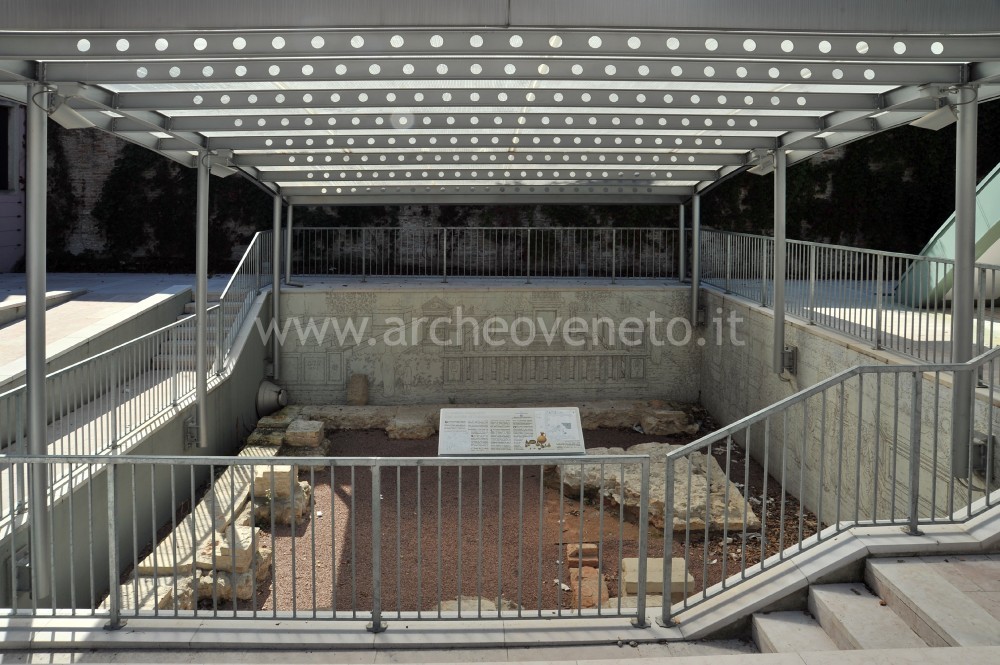Via Beato Pellegrino 1 - 35100 Padova (PD)
Tel. 049 8274800 - Fax 049 8274801 |
Web site http://www.maldura.unipd.it |
|
Summary
The archaeological area at "Palazzo Maldura" displays the remains of one of the main necropolis in Padua at Roman times. It is particularly possible to see part of a funerary enclosure dating back to the first half of the I century A.D. On its inside the archaeologists have recovered an urn containing the ashes of the dead.
History of research
The excavations were started in 1996 by the University of Padua within the restoration project of the public library at "Palazzo Maldura". The archaeological area was inaugurated in 2007.
Urban and geographical context
Padua is located at the eastern margins of the Po plain, in a completely flat area crossed by various rivers that have shaped and protected the city through time. This archaeological area is located in the centre of the city.
Chronology
I A.D. |
 |  |
Roman funerary enclosure at "Palazzo Maldura"  The archaeological area at “Palazzo Maldura” displays the remains of one of the main necropolis in Roman Padua, the northern one, which extended south up to the street “via Bartolomeo Cristofori”. What we can see today pertains to two different phases of the necropolis. The first phase dates to mid I century B.C. and was constituted by a funerary enclosure with family graves. It is documented by a grave (A) with a cinerary urn in grey pottery that contained the ashes of a dead person and by the bricks wall (B) of the enclosure.
Between the first and the second phase this area underwent a general reorganization, which led to the flattening of the ground and the demolition of the enclosure’s wall. This process damaged the cover of the urn, which was slightly moved from its primary position. The area hosted a new funerary enclosure which has been dated to the I century A.D. and which is documented today by the bricks mortar-linked wall (C) and by the squared basis of a funerary monument (D). The main façade of the enclosure was probably located on its western side, which today is missing because it was eroded by the Bovetta channel. The enclosure wall has a series of recesses with uncertain function, that might have served to support other funerary monuments. Within the enclosure the archaeologists have found a stone urn containing the ashes and grave goods of one person (E).
Another group of burials was found north and south to the enclosure. Particularly, the southern one is separated from the main enclosure by a stone marker (F) with a cross on top that defined the boundaries between the two funerary areas. This group of burials includes two children graves, both heading north and buried in a grave covered by tiles (H, I), that have been dated to Tiberian times.
This area was used at least until the II century A.D. as it is demonstrated by the finding of other burial contexts south of the enclosure, and particularly the grave of an adult (G) and of a child (L). The archaeological area at “Palazzo Maldura” displays the remains of one of the main necropolis in Roman Padua, the northern one, which extended south up to the street “via Bartolomeo Cristofori”. What we can see today pertains to two different phases of the necropolis. The first phase dates to mid I century B.C. and was constituted by a funerary enclosure with family graves. It is documented by a grave (A) with a cinerary urn in grey pottery that contained the ashes of a dead person and by the bricks wall (B) of the enclosure.
Between the first and the second phase this area underwent a general reorganization, which led to the flattening of the ground and the demolition of the enclosure’s wall. This process damaged the cover of the urn, which was slightly moved from its primary position. The area hosted a new funerary enclosure which has been dated to the I century A.D. and which is documented today by the bricks mortar-linked wall (C) and by the squared basis of a funerary monument (D). The main façade of the enclosure was probably located on its western side, which today is missing because it was eroded by the Bovetta channel. The enclosure wall has a series of recesses with uncertain function, that might have served to support other funerary monuments. Within the enclosure the archaeologists have found a stone urn containing the ashes and grave goods of one person (E).
Another group of burials was found north and south to the enclosure. Particularly, the southern one is separated from the main enclosure by a stone marker (F) with a cross on top that defined the boundaries between the two funerary areas. This group of burials includes two children graves, both heading north and buried in a grave covered by tiles (H, I), that have been dated to Tiberian times.
This area was used at least until the II century A.D. as it is demonstrated by the finding of other burial contexts south of the enclosure, and particularly the grave of an adult (G) and of a child (L). |
|
Visiting
Admission: Negli orari di apertura;
Visitability: Esterno;
Ticket: No;
 School access School access
|
| Tipology | When | Specs |
|---|
| Only | Friday | 07.45-20.00 | | Only | Monday | 07.45-20.00 | | Only | Saturday | 07.45-13.00 | | Only | Thursday | 07.45-20.00 | | Only | Tuesday | 07.45-20.00 | | Only | Wednesday | 07.45-20.00 |
Recommended tour time (minutes): 20
|
|
Services for visitors
|
Educational Services
 Information boards Information boards
|
Bibliography
| Balestrazzi E., Veronese F., Vigoni A. 2007, Un recinto funerario di epoca romana a Palazzo Maldura a Padova, in Quaderni di Archeologia del Veneto, XXIII, pp. 139-146. |


 School access
School access
 Information boards
Information boards